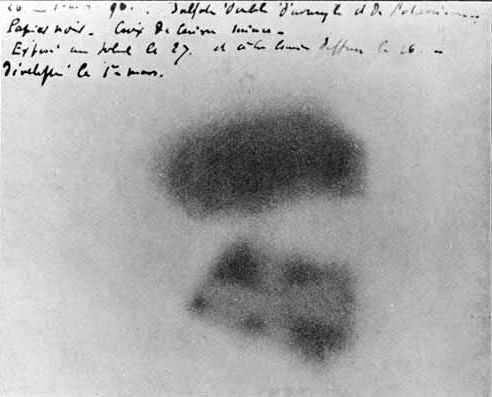
The Discovery of Radioactivity
 المؤلف:
LibreTexts Project
المؤلف:
LibreTexts Project
 المصدر:
................
المصدر:
................
 الجزء والصفحة:
.................
الجزء والصفحة:
.................
 31-8-2020
31-8-2020
 1554
1554
The Discovery of Radioactivity
No one could have known in the 1800's that the discovery of the fascinating science and art form of photography would eventually lead to the splitting of the atom. The basis of photography is the fact that visible light causes certain chemical reactions. If the chemicals are spread thinly on a surface but protected from light by a covering, no reaction occurs. When the covering is removed, however, light acting on the chemicals causes them to darken. With millions of cameras in use today we do not think of it as a strange phenomenon, but at the time of its discovery photography was a strange and wonderful thing.
Even stranger was the discovery by Roentgen, that radiation other than visible light could expose photographic film. He found that film wrapped in dark paper would react when x-rays went through the paper and struck the film.

Figure 1 : Image of Becquerel's photographic plate which has been fogged by exposure to radiation from a uranium salt. The shadow of a metal Maltese Cross placed between the plate and the uranium salt is clearly visible (Public Domain).
When Becquerel heard about Roentgen's discovery, he wondered if his fluorescent minerals would give the same x-rays. Becquerel placed some of his rock crystals on top of a well-covered photographic plate and sat them in the sunlight. The sunlight made the crystals glow with a bright fluorescent light, but when Becquerel developed the film he was very disappointed. He found that only one of his minerals, a uranium salt, had fogged the photographic plate. He decided to try again, and this time, to leave them out in the sun for a longer period of time. Fortunately, the weather didn't cooperate and Becquerel had to leave the crystals and film stored in a drawer for several cloudy days. Before continuing his experiments, Becquerel decided to check one of the photographic plates to make sure the chemicals were still good. To his amazement, he found that the plate had been exposed in spots where it had been near the uranium containing rocks and some of these rocks had not been exposed to sunlight at all. In later experiments, Becquerel confirmed that the radiation from the uranium had no connection with light or fluorescence, but the amount of radiation was directly proportional to the concentration of uranium in the rock. Becquerel had discovered radioactivity.
 الاكثر قراءة في الكيمياء الاشعاعية والنووية
الاكثر قراءة في الكيمياء الاشعاعية والنووية
 اخر الاخبار
اخر الاخبار
اخبار العتبة العباسية المقدسة


